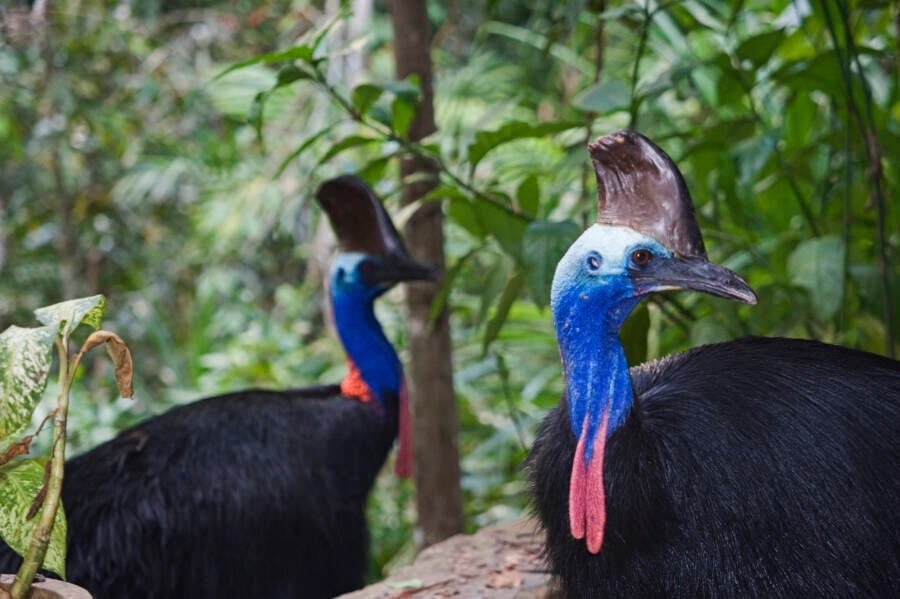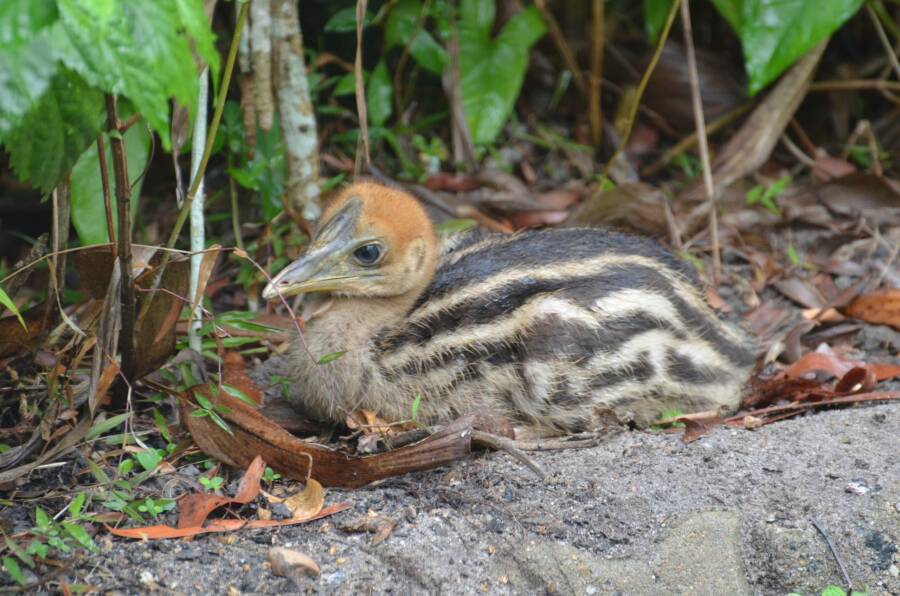Fossilized eggshells in New Guinea suggest early humans stole cassowary eggs just before they were going to hatch.

Education Images/Universal Images Group via Getty ImageCassowaries have been compared to dinosaurs.
The colorful cassowary is grumpy, standoffish, and can be aggressive. It even has four-inch, razor-sharp talons that can slice through human flesh. But a new study suggests that long before people started rearing chickens, they tried domesticating cassowaries.
The study, published in Proceedings of the National Academy of Science, argues that early humans collected and hatched cassowary eggs as long as 18,000 years ago in Papua New Guinea.
“This is thousands of years before domestication of the chicken,” explained Kristina Douglass, an archaeologist at Penn State University and the lead author of the study. Early humans domesticated chickens some 9,500 years ago.
She added, “This is not some small fowl, it is a huge, ornery, flightless bird that can eviscerate you.”
Douglass and her team examined fossilized cassowary eggshells in Papua New Guinea from 18,000 to 6,000 years ago. By comparing the eggshells with how modern eggs develop, they determined that most of the shells were near maturity.
“What we found was that a large majority of the eggshells were harvested during late stages,” Douglass said. “The eggshells look very late; the pattern is not random.”
Some of the eggshells have burn marks, however. Douglass acknowledges that this means that they were likely eaten, similarly to how southeast Asian countries eat balut.
“We also looked at burning on the eggshells,” she said. But “there are enough samples of late-stage eggshells that do not show burning that we can say they were hatching and not eating them.”
Douglass suspects that early humans collected eggs from dwarf cassowaries. Though the smallest species of cassowary, they can grow up to 44 pounds.

San Francisco Zoo/TwitterThe cassowary has long, lethal talons, which would have made hunting its eggs difficult.
It would have been extremely difficult for early humans to gather cassowary eggs. First of all, they would need to know where the cassowaries kept their nests. Cassowary nests are notoriously hard to find, as the birds don’t return to the same nests every year.
Next, they would have to steal the eggs themselves. After female cassowaries lay their eggs, male cassowaries generally guard the nest for 50 days. So early hunters would need to kill or evade the male to steal the eggs.
All of this, says Douglass, suggests that early humans in Papua New Guinea had a deep understanding of the world around them.
“It suggests that people who are in foraging communities have this really intimate knowledge of the environment and can thus shape it in ways we hadn’t imagined,” she said.
That said, it is unclear what exactly early people did with the cassowary chicks. But clues may exist in present-day humans.
In Papua New Guinea, indigenous groups still take eggs from cassowary nests. Their feathers are used in rituals and for trading, and their meat is considered a delicacy. Since chicks imprint easily — even on humans — they’re easy to tame. It’s a different story once the chicks reach adulthood.

Wikimedia CommonsCassowary chicks are much more manageable than adults.
“It is possible cassowaries were also highly valued in the past, since they are among the largest vertebrate animals on New Guinea,” explained Douglas.
“Raising cassowaries from chicks would provide a readily available source of feathers and meat for an animal that is otherwise challenging to hunt in the wild as an adult.”
However, it’s not a good idea to go out and try to find some cassowary eggs — or even to seek out the full-fledged adults. Cassowaries have been known to attack humans.
Usually, they only attack to defend themselves or their eggs. Sometimes, they’ll attack if someone has fed them in the past, and they’re expecting more food. Cassowaries will charge, kick with their sharp talons, peck, and head-butt.
In 1926, a cassowary kicked an Australian teenager trying to hunt it. The bird’s talon sliced his throat, killing him. And in 2019, a captive cassowary in Florida killed its owner, possibly because he fell down.
All that’s to say, it might be best to stick with eating chicken eggs for now.
After reading about how early humans tried raising cassowaries, learn about some of the world’s scariest birds. Or, look through this list of dangerous animals.





